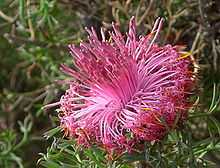Drummond Nature Reserve

The Drummond Nature Reserve is an A class nature reserve 10 kilometres west of Bolgart, Western Australia. Named after the botanist James Drummond, the reserve has 439 species of vascular plants within its boundaries, including two rare and seven priority species.
History
In 1993 the land was purchased by the Mundaring district office of the Department of Conservation and Land Management and gazetted as an A class reserve. Prior to purchasing the land was uncleared freehold grazing land. Despite this use the land was in excellent condition, though evidence of grazing impact was visible in part of the eastern area of the reserve. The reserve was named after botanist James Drummond who lived in nearby Toodyay. Between 1841 and 1844 Drummond explored and collected specimens in the area which were part of his second collection.[1][2][3]
Topography and vegetation
The Drummond Nature Reserve is constructed with a series of lateritic hills with spillway deposits plus a small outcrop of bedrock. There have been ten different vegetation areas identified, and these are based on different soil types, topography and drainage. The area has six different woodland types, two granite heath types, a mallee vegetation type and the last two claypan wetland areas remaining in the state.[1][4]
The North west corner is a Wandoo Woodland that has been affected by salinity most of the trees are either dead or affect by dieback, the understory has died and been replace by weeds. The granite areas have two types one is an area covered by Xanthorrhoea preissii, Gastrolobium calycinum with a Borya herbfield and the other is dominated by Melaleuca, Dodonaea also with a herbfield of Borya. The soil of mallee area is a yellow sandy clay with the dominant plants being the low dense Eucalyptus drummondii and Allocasuarina.[1]
Flora
During 1999 and 2000 the first major survey of the plants species was conducted on foot, which identified 439 species of vascular plants. This consisted of 405 native plant species and 35 alien plant species. There were two declared rare flora; the aquatic herb Trithuria leptogyne (this is the only known location of this species) and Eleocharis keigheryi in two population groups.[1][5] Additionally there are seven priority species in the reserve these are;
| species | priority |
|---|---|
| Acacia chapmanii subsp. australis | rare[6][7] |
| Comesperma rhadinocarpum | two |
| Tricoryne arenicola | two |
| Platysace ramosissima | three |
| Stenanthemum tridentatum | three |
| Hydrocotyle lemnoides | four |
| Schoenus natans | four |
In addition there have some other factors of interest in the flora of the Drummond Nature Reserve. The occurrence of Cyathochaeta equitans is the only known inland population, as this species is found predominantly in the sands of the Swan Coastal Plain. A hybrid of Eucalyptus loxophleba has been found with the reserve, Schoenus aff. loliaceus which may be a new species of Schoenus and Rhodanthe pyrethrum is at it northern limit.[1]
References
- ↑ 1.0 1.1 1.2 1.3 1.4 G.Keighery, N.Gibson, A.Webb and W.P.Muir (2002). "A biological survey of the agricultural zone : vegetation and vascular flora of Drummond Nature Reserve". Conservation Science W. Aust. 4 (1) :. Department of Conservation and Land Management. pp. 63–78. Retrieved 2008-08-29.
- ↑ Serle, Percival (1949). "Drummond, James". Dictionary of Australian Biography. Sydney: Angus and Robertson.
- ↑ Nelson, Charles. "Drummond, James (c. 1786 – 1863)". Bright Sparcs. University of Melbourne. Retrieved 2008-08-29.
- ↑ "DRUMMOND NATURE RESERVE, FRESHWATER CLAYPAN WETLANDS". Legislative Assembly of Western Australia Hansard for 18 November 2003. WA Government. 18 November 2003. Retrieved 2008-08-29.
- ↑ "Hydatella leptogyne — Few-flowered Hydatella". Species profile and Threats database. Department of Environment, Water and Heritage. Retrieved 2008-08-29.
- ↑ "Acacia chapmanii subsp. australis". FloraBase. Department of Environment and Conservation, Government of Western Australia.
- ↑
Further reading
- Keighery, G. J. (2002) A biological survey of the agricultural zone: vegetation and vascular flora of Drummond Nature Reserve. (with Gibson, N., Webb, A., and Muir, W. P. in Conservation science Western Australia, Vol. 4, No. 1 (Aug. 2002), pp. 63–78
- (1992) Drummond Nature Reserve — process of creating the reserve WANPARA news, Dec. 1992, p. 7,
Photo gallery
-
Northern project sign
-
Catchment project sign
-
Threatened Ecological Community sign
-
DEC Nature Conservation Monitoring Site sign — Perth Hills District, Swan Region
-
Old Calm sign with various labels, Marsh area of south west corner in background
-
Isopogon dubius
-
Grevillea bipinnatifida
-
Orthrosanthus laxus
External links
| Wikimedia Commons has media related to Drummond Nature Reserve. |
Coordinates: 31°19′01″S 116°24′25″E / 31.317°S 116.407°E







